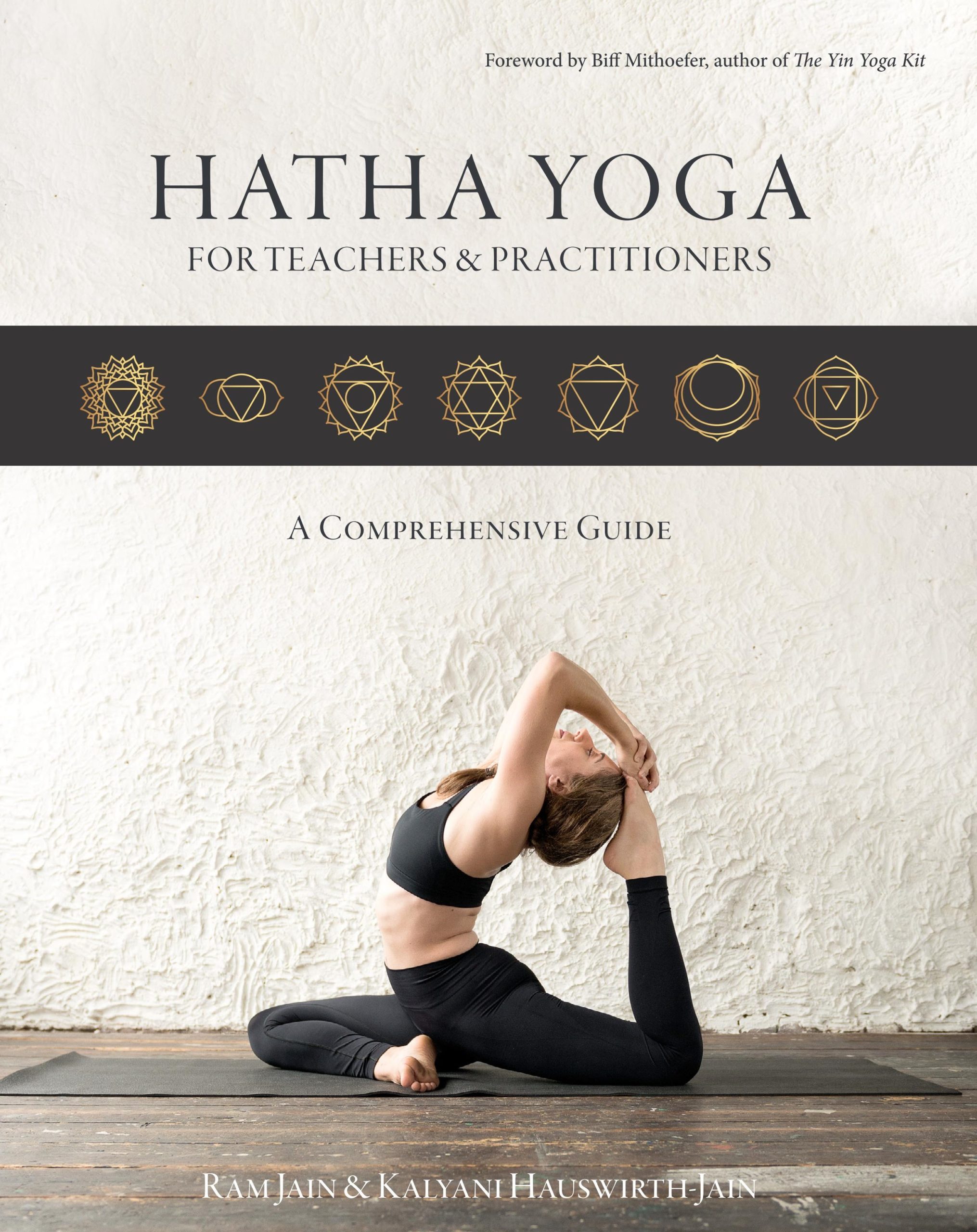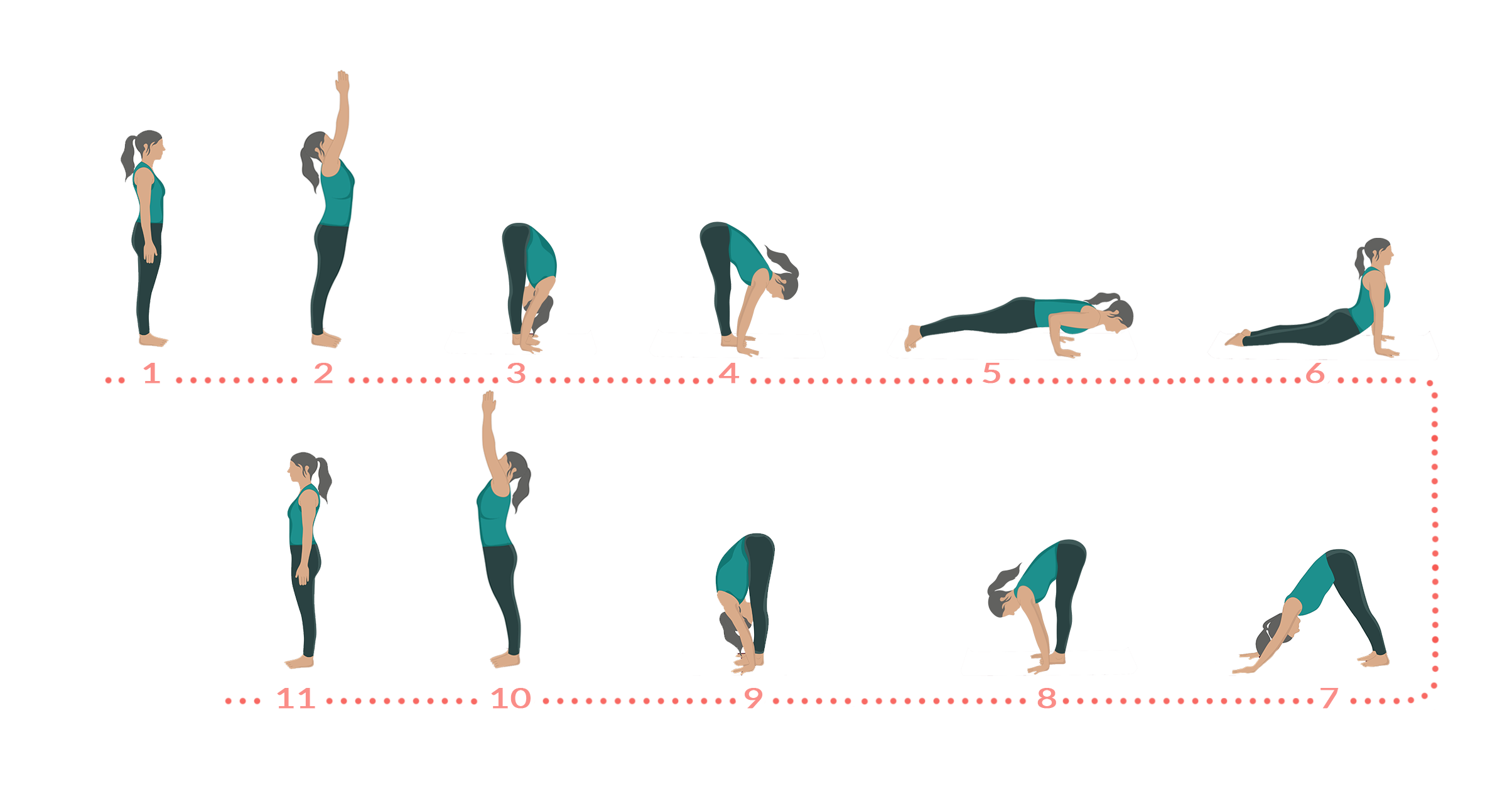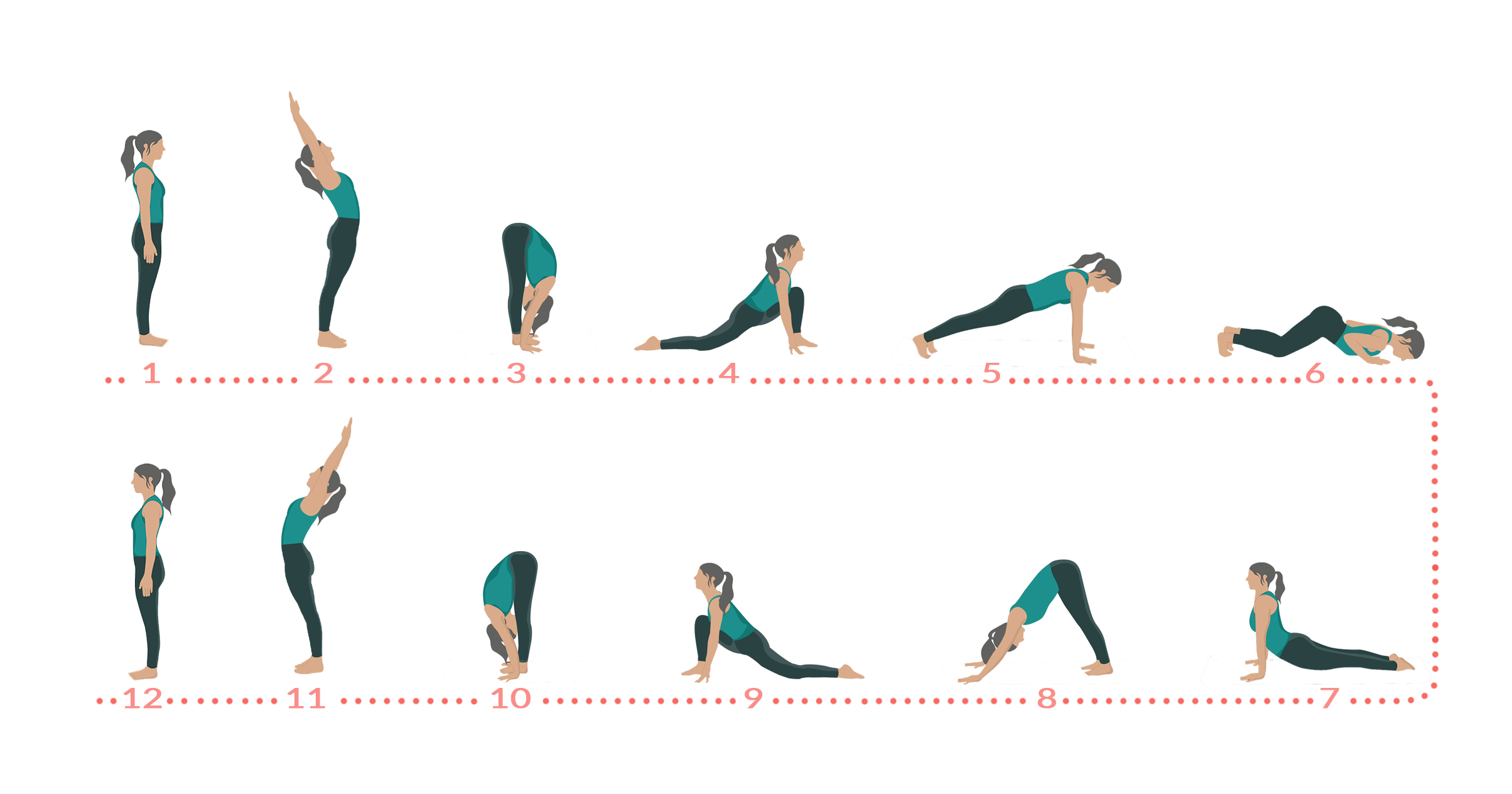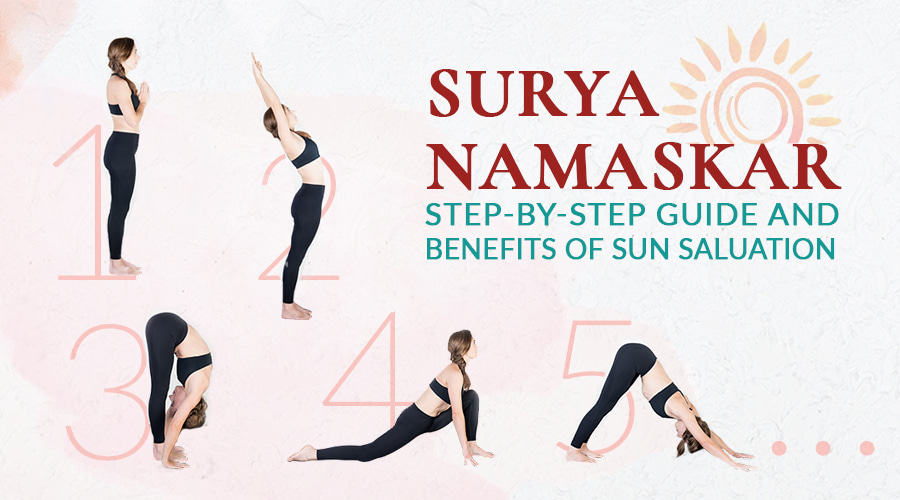In the ancient language of Sanskrit, 'surya' refers to the sun, and 'namaskar' means greeting or salute. So, Surya Namaskar is essentially a salutation to the sun. It's a sequence of twelve steps that's been around for a very long time, meant to warm up your body and prepare it for yoga. That's why it's often the first thing done in a yoga class. However, it's more than just a warm-up. This sequence carries a rich history and provides whole-body benefits.
Continue reading to discover more about the origin of Sun Salutations, its health benefits, and how to do and teach the steps correctly.
What Is the Meaning of Surya Namaskar Kriya?
Kriyā is a Sanskrit term. It is derived from the Sanskrit root, “kri”, meaning "to do''. Kriyā means "action, deed, effort". The correct way to refer to Sun Salutations, is to call it a kriya.
Surya Namaskara is an action consisting of 12 steps. Unlike popular belief, it is not a series of asanas. Surya Namaskara Kriya is associated with the solar plexus and helps raise solar energy within the body.Mythology & Tradition Behind Surya Namaskar
In the Vedas, everything in the universe has a male and female side. The female side of the sun is depicted as Gayatri in Hindu mythology, representing a nourishing and life-giving force, while the male side is depicted as Surya. We can therefore think of Gayatri like yin energy and Surya like yang energy.
The purpose of Sun Salutations is to warm-up and invigorate the body for the following asana practice. Contrary to common belief, Surya Namaskara Kriya is practiced facing away from the rising sun. Traditionally, you would greet the rising sun with a bow and prayer, facing your back to it to absorb its energy from behind.
By doing this, we stimulate the back and spine and warm up the body for more challenging asanas. As Surya gave life to the world through this powerful energy, we too can invigorate our body through the practice of Surya Namaskar.
Why Should You Practice Surya Namaskar? Benefits of Sun Salutations
There are numerous reasons why you should never skip Sun Salutations. Firstly, Surya Namaskar is a vital warming-up sequence that allows for “opening” of the body as it stretches, strengthens, and lengthens all muscle groups. This practice also stimulates prana (life force energy), helping to regulate our mental and physical faculties.
Today, there are various studies emerging on the benefits of sun salutations and yoga for our mental and physical health. Here, we look at some of these benefits.
Physical Health Benefits
Although Surya Namaskar can be practiced at any time of the day, it is best to practice at sunrise as sun rays help revitalize the body and the mind. Surya Namaskar can be done in a 3-speed variation: slow, medium, or fast. A slowed pace helps increase body flexibility, while a medium pace builds muscle tone. Fast-paced rounds of Surya Namaskar are beneficial for your cardiovascular health and can aid in weight loss. Other physical benefits include:
Improved Blood Circulation
Surya Namaskar helps improve blood circulation and strengthen heart function. It also enhances the resting cardiovascular parameters, such as systolic blood pressure, diastolic blood pressure and pulse pressure.
Increased Oxygenation
During Sun Salutations, more alveoli of the lungs are expanded, stimulated and then cleansed. Alveoli are tiny, balloon-shaped air sacs that work as basic respiratory units. Their function is to move oxygen and carbon dioxide (CO2) molecules into and out of the bloodstream.
Through the rhythmic breathing of Sun Salutations, the oxygen content of the blood is increased. This improves oxygenation of the body, especially the heart and brain. The cardiac muscles also improve through this rhythmic breathing and movement.
Boosts Gut Health
Surya Namaskar is also beneficial for digestive health and other systems of the body as the asanas interact with the organs of the body directly, by applying pressure, massaging, stretching and toning the muscles. This aids the elimination processes of the body.
Read more: How Yoga Can Improve Digestion – 8 Yoga Poses for Better Digestion
Mental Health Benefits
Consistent practice of Surya Namaskar sharpens your focus, improves self-confidence, and helps you develop self-discipline. It calms the nervous system and can contribute to managing anxiety, depression, and insomnia.
Get a free copy of our Amazon bestselling book directly into your inbox!
Learn how to practice, modify and sequence 250+ yoga postures according to ancient Hatha Yoga principles.
How Many Sun Salutations Should You Do Daily?
The number of rounds you do will vary depending on your fitness level, if you have any injuries or ailments, and your technique. It is best to go slow, get comfortable with the steps and sync your breath to movement with five to six rounds a day. As you build more strength and endurance, you can move to six rounds. Classically in Hatha Yoga, nine rounds of Surya Namaskar are used to warm up the body.
If you have high blood pressure, hernia, coronary artery diseases and any wrist, shoulder or lower back injuries, you are advised to practice Easy Classical Surya Namaskara, explained below. Those with spine and back problems should consult a doctor before practicing Surya Namaskar. Thereafter, variations should be sought from a qualified and capable teacher.
Read more: Yoga for Lower Back Pain
How to Choose the Right Pace in Surya Namaskar
Slow Pace
The slow Surya Namaskar practice is said to have a meditative effect if the breath and mind are kept in harmony. Slow paced Surya Namaskar is also beneficial in strengthening muscles and improves the functioning of internal organs. It also helps control diastolic blood pressure. Beginners benefit greatly from a slow-paced practice as they are able to better focus on bodily alignment, technique, and breathing coordination of each step.
Intermediate Pace
When Surya Namaskar is done at a medium pace, its effects are similar to those of aerobics with increased muscular endurance and power. A slightly faster set of 3 to 12 rounds should be done for the physical benefits. Beginners should start with 2-4 rounds at a faster pace and should add an extra round after every few days or every week to avoid exertion.
Fast Pace
Faster rounds of Surya Namaskar are considered as a cardiovascular workout. It helps burn excess fat from the body, and are very good as a warm-up exercise. More experienced practitioners would benefit from a faster pace as they have experience in focusing on their breathing, technique, and coordination.
How to Do Surya Namaskar: Classical Vs. Modern Sun Salutations
Modern Surya Namaskar A (Ashtanga Vinyasa)

Classical Surya Namaskara (Hatha Yoga)

Differences Between Classical & Modern Surya Namaskar
The classical version of Sun Salutations in Hatha Yoga tradition sees the spine flow through a range of beneficial movements which allow for extension and flexion. These 12 steps truly aid in warming up and lubricating the spine for movement, while the modern version practiced in Ashtanga Vinyasa Yoga provides more of a cardiovascular challenge. Here are a few other key differences to keep in mind when practicing these two sequences.
Standing forward bend position
Classical (Hatha): Back is rounded and knees are soft, providing a gentle stretch along the spine.
Modern (Ashtanga Vinyasa): Back is elongated and knees should be straight.
Stepping back to plank
Classical: Move through a low lunge position with the chest lifted and pelvis pushing forward.
Modern: Hop or quickly step back.
Lowering to the mat
Classical: Move the spine to gently stretch your thoracic and cervical spine.
Modern: Lower flat down.
Downward-Facing Dog
Classical: Keep the feet and hands in plank position and aim to bring your chest toward the knees.
Modern: Shorten the stance to bring the majority of the stretch to the back of our legs and glutes.
How to Teach Surya Namaskar (Hatha Yoga)
During Sun Salutations, you use hundreds of muscles, regulate the breathing, and center your thoughts. As a result, it is highly recommended to start every practice of yoga asana with Surya Namaskara. By doing so, you not only help your students warm up their spines, but it’s a great way to boost body's energy for practice. If you want to incorporate Surya Namaskar in your classes, use these simple instructions for a well-rounded and fluid practice.
Classical Surya Namaskar
1. Stand straight, with spine erect and shoulders relaxed. Your feet are hip-width apart. Your knees are straight but not hyper-extended and your arms are relaxed next to your body.
- Shoulders and elbows are relaxed
- Knees are straight but relaxed
- Back of your neck is long
- Reach up with the crown of your head toward the ceiling
2. Breathe in and reach with your arms up and backward
- Arms should be alongside your ears
- Look upward; do not drop your head back
- Knees are straight and hips are pushing slightly forward
3. Breathe out and bend forward, placing your palms on the floor, outside of your feet
- If you cannot place your palms on the floor with your knees straight, you can bend your knees slightly
- Reach with your nose toward your knees
4. Keeping your hands there, inhale, and bring your right leg back as far as possible
- Place your right knee on the floor and point your right foot
- Push the pelvis forward, without losing the 90-degree angle of your left knee
- Open your chest, look diagonally upward while the palms remain on the floor
5. Hold the breath and bring your left leg back
- Your body is in a straight line from your head to your heels (push-up position)
6. Breathe out and drop your knees, chest, and forehead to the floor
- Without moving your body backward, bring your chest down to the floor between your hands and then bring your forehead to the floor
- Knees, chest, and forehead are touching the floor but the hips are off the floor
7. Breathe in and scoop up
- Open your chest and look up and back without dropping the head
- Legs remain on the floor, feet are pointed
- Do not move your hands as you come into this position
- Elbows are slightly bent tucked in toward your body, and your shoulders are pushing down
8. Breathe out, curl your toes and push the hips up
- Without moving your hands or feet, push your hips toward the ceiling
- Your hands are flat on the floor; heels can be slightly lifted off the floor
- Head is between your arms. Now, look at your feet, trying to bring your chest to your knees. This pose is also known as the ‘Inverted V Pose’
9. Breathe in and bring the right foot forward in between your hands
- Keep your fingers and toes in one line
- Drop your left knee to the floor, point your left foot, and push your pelvis forward toward your right heel
- Look diagonally upward—the same as in position 4
10. Breathe out, and keeping your hands where they are, curl the toes of your left foot and step your left foot forward, next to your right foot
- Nose in between your knees, hands holding your ankles
- Keep the knees straight
11. Breath in and reach with your hands out and upward
- Arch backward—the same as in position 2.
12. Bring your palms down in front of your chest, then return to the beginning position
- Breathe out, palms together in front of your chest.
This completes half a round. Repeat to the left (left leg stepping first back and forward) to complete one full round of Sun Salutation. Perform 6 – 8 rounds, then rest in Corpse Pose.
Easy Classical Surya Namaskara
The beginner friendly variation of the Sun Salutation sequence can be done and applied by anyone with restricted movement, whether from injury or a chronic condition, old age, or pregnancy.
1. Stand straight, with your spine erect and shoulders relaxed
- Your feet are shoulder-width apart
- Your knees are straight but not hyper-extended
- Your arms are relaxed next to your body
2. Breathe in and out, bringing your palms together in front of your chest. Shoulders and elbows are relaxed
- Knees are straight but relaxed
- Back of your neck is long
- Reach up with the crown of your head toward the ceiling
3. Breathe in and reach your arms up toward the ceiling
- Your arms are alongside your ears
- Look straight forward, with the back of your neck elongated
- Keep your spine’s natural curve
- Do not arch your lower back or tuck your tailbone under
4. Breathe out, reach forward and out, placing your palms on the floor, in front of or in between your feet
- Knees are slightly bent. Look in between your knees, with the crown of your head reaching toward the floor
5. Keep your hands there, breathe in and bring your right knee behind you on the floor
- Your knee is resting below your pelvis on the floor
- Look forward, opening your chest and keeping the back of your neck elongated
6. Breathe out and bring your left knee behind you to the floor
- Your knee is resting below your pelvis on the floor
- Look to the floor, with the back of your neck elongated
- Keep your arms perpendicular to the floor, with your hands directly under your shoulders and flat on the floor
- Your knees are hip-width apart
7. Breathe in, push your belly button toward the floor, raise your chin, and lift your tailbone
- Your elbows are straight and shoulders are away from your ears
8. Breathe out and round your spine toward the ceiling
- Keep your hands and knees in their original positions
- Release your head toward the floor, but avoid forcing your chin toward your chest
9. Breathe in and bring your right foot forward outside your right hand
- Your left knee remains on the floor
- Look forward, open your chest and keep the back of your neck elongated
10. Breathe out, keeping your hands where they are, and bring your left foot forward outside your left hand
- Your knees are slightly bent
- Look in between your knees, with the crown of your head reaching toward the floor
11. Breathe in and reach your hands forward and up to the ceiling
- Your arms are alongside your ears
- Look straight forward, with the back of your neck elongated
- Keep your spine’s natural curve. Do not arch your lower back or tuck your tailbone under
12. Breathe out, bringing your hands in front of your chest, palms together
This completes half a round. Repeat to the left (left leg stepping first back and forward) to complete one full round of Sun Salutation. Perform 4–8 rounds, then rest in Corpse Pose.
Conclusion
Sun Salutation is an important practice in Hatha Yoga. It harmonizes the movements of your body with your breath and this rhythmic process done in the early morning has many mental, physical and energetic benefits. Therefore, performing a few rounds of Surya Namaskar before starting your regular routine or practicing it on its own is essential to your yoga practice.
Resources
- Jain, R. and Hauswirth-Jain, K., 2017. Hatha Yoga for Teachers and Practitioners: A Comprehensive Guide.
- A comparative study of slow and fast Surya namaskar on physiological function
- Ananda Balayogi Bhavanani, Kaviraja Udupa, Madanmohan, PN Ravindra .Int J Yoga. 2011 Jul-Dec; 4(2): 71–76. doi: 10.4103/0973-6131.85489 Effect of Pranayama and Suryanamaskar on Pulmonary Functions in Medical Students

Get a free copy of our Amazon bestselling book directly into your inbox!
Learn how to practice, modify and sequence 250+ yoga postures according to ancient Hatha Yoga principles.

